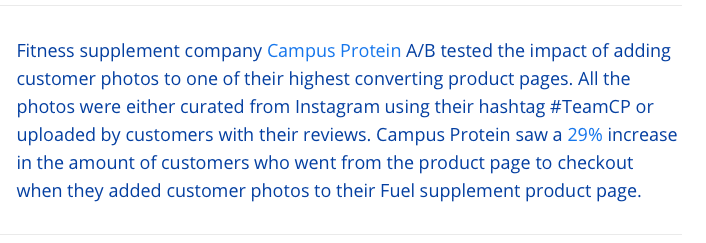Most online retailers are aware of the benefits of customer reviews on product pages – SEO E-E-A-T, social proof, increased overall trust signals, and increased conversation rates. Customer reviews help spark engagement with a product and increase the likelihood of an on-the-spot purchase.
Over the years we’ve worked with several clients who couldn’t display customer reviews on product pages for valid reasons (government regulations, negative reviews or brand image in the luxury space).
So, we were forced to come up with alternatives to customer reviews on product pages. One approach, that can be adopted by any e-commerce website, is to integrate customer reviews with your social media strategy.
Using this approach, you would display curated social media posts on product pages instead of customer reviews. You can start by pulling posts from our own channels and then add customer and influencer posts as they become available.
#1 Making Customer Reviews More Subtle
Let’s start by first reviewing a product page from the Neiman Marcus website:

Neiman Marcus posts reviews at the bottom of the page, giving the consumer the opportunity to first learn more about the product itself and related items.
Not only are the reviews displayed in a clear and crisp manner, but it doesn’t take up much space on the page. With this approach, the review feature only attracts attention if the customer is looking for it, while still providing SEO value.
#2 Social Media as an Alternative to eCommerce Reviews
Social Media is a great Alternative to Customer Reviews on Product Pages, both for SEO and for general user experience. With social media becoming such a big part of establishing a brand online, it makes sense to integrate this on product pages.
There are many reasons why this is preferential when compared to a more traditional approach (see the example above):
- More engaging information, thanks to the use of user-generated photos
- Less concern about negative reviews
- Provide a unique look and feel on each page
Campus Protein – a brand that has built itself largely on social media – is a great example of a company using Instagram as an alternative to traditional product reviews.
On product pages, you can add a slider feed or carousel from a social media network such as Instagram.
With this example, consumers have the opportunity to see a product – the product they’re interested in – in action. Clicking on the image enlarges it, while also displaying comments and hashtags.
While this approach is “louder” and more “in your face” than traditional reviews, it all depends on the placement. Before they get to these images, users should first see:
- A product description, complete with cost
- Items that are frequently bought together
- Multiple “add to cart” buttons
- Nutrition facts and ingredients
Campus Protein had previously used this strategy, which was recognized by Yotpo, a leading digital marketing platform provider for eCommerce brands. Here’s what Yotpo had to say:

With such a large increase in the number of customers reaching the checkout page, it’s safe to assume that the addition of Instagram photos has had a positive impact on both sales and revenue.
Do Product Pages Need to Have Reviews?
There are times when it makes sense to include customer reviews on product pages. There are also situations when using social media, such as Instagram, provides the opportunity to leverage influencer and customer posts.
With the right approach, you’re putting your online store in position to improve the customer experience and boost sales.
Interested in learning more about the importance of online reviews in marketing and sales? See our resources here:


